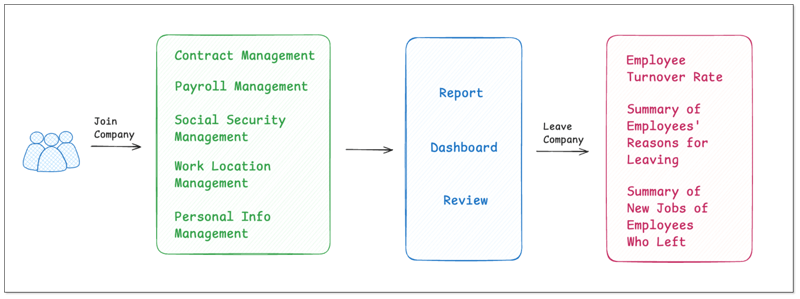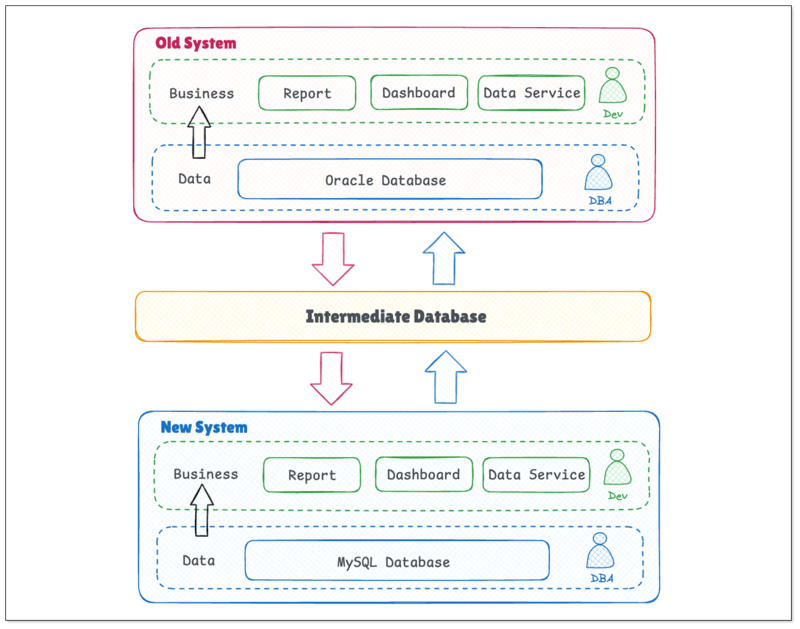A Top HR Service Company Replaces its System Seamlessly with BladePipe
Enterprise System Replacement: A Case Study of Seamless Switchover
The need for enterprise system replacement stems from a variety of factors: for example, the business needs smarter systems to fuel growth, or the business finds a more cost-effective alternative. However, this is no easy task. One of the difficulties is how to minimize downtime while replacing the system.
This article will delve into a real-life case of a top human resources services company to understand how it seamlessly replaced its human resources management system.
Business Structure
In this case, the company’s goal was to replace an outdated human resources management system with a new system. The old system integrated management functions such as employee contracts, payroll, social security, and location. In order to meet the company's new needs, a more feature-rich system needs to be developed. This involves the reconstruction of data stored in the system.

Technical Architecture
The old system is based on Oracle database, and the new system is based on MySQL database. Data exchange takes place via an intermediate Oracle database.
Reasons for adding an intermediate database to your schema include:
- Network Complexity
- Continuous human resources service needs based on production data and data security
- There are differences in how the old system and the new system use the data stored in the database
The image below depicts how the system can be replaced seamlessly:

Challenge
In order to smoothly replace systems while maintaining HR services, live data migration is a critical step. Multiple data pipelines must be built to enable the following data migrations:
- Convert and migrate existing data in the old system to the intermediate database, and synchronize incremental data to the intermediate database in real time.
- Migrate the required data from the new system to the intermediate database, and then load the data from the intermediate database to the old system in real time.

There are the following difficulties in this process:
- Maintain stability across multiple data pipelines.
- Ensure data accuracy across replicated heterogeneous data sources.
- Minimize latency. Keep the delay to a few seconds.
Why choose BladePipe?
The human resources services company chose BladePipe after comparing several data migration tools. Key factors that led the company to choose BladePipe include:
- An intuitive interface makes data pipeline configuration easier than ever. No code is required during configuration.
- Can automatically complete schema migration, complete data migration and incremental data synchronization.
- Continuous monitoring and automatic alert notifications significantly reduce operation and maintenance costs and stress.
- It has powerful data migration capabilities between heterogeneous data sources. Embedded data pruning, mapping, and filtering capabilities help developers work more efficiently.
- Supports custom code, allowing highly flexible personalization.
Results
HR services company successfully replaced system using BladePipe. The new system has been in operation for several months.
Conclusion
In order to replace the system without affecting the business, real-time data synchronization is often an indispensable step. BladePipe perfectly meets these needs, with many advantages such as ease of use, powerful functions, and ultra-low latency. It has proven to be a powerful tool that helps companies replace systems reliably and efficiently.
The above is the detailed content of A Top HR Service Company Replaces its System Seamlessly with BladePipe. For more information, please follow other related articles on the PHP Chinese website!

Hot AI Tools

Undress AI Tool
Undress images for free

Undresser.AI Undress
AI-powered app for creating realistic nude photos

AI Clothes Remover
Online AI tool for removing clothes from photos.

ArtGPT
AI image generator for creative art from text prompts.

Stock Market GPT
AI powered investment research for smarter decisions

Hot Article

Hot Tools

Notepad++7.3.1
Easy-to-use and free code editor

SublimeText3 Chinese version
Chinese version, very easy to use

Zend Studio 13.0.1
Powerful PHP integrated development environment

Dreamweaver CS6
Visual web development tools

SublimeText3 Mac version
God-level code editing software (SublimeText3)
 How to format dates in MySQL?
Sep 19, 2025 am 02:06 AM
How to format dates in MySQL?
Sep 19, 2025 am 02:06 AM
MySQL's DATE_FORMAT() function is used to customize the date and time display format. The syntax is DATE_FORMAT(date, format), and supports a variety of format characters such as %Y, %M, %d, etc., which can realize date display, group statistics and other functions.
 How to use a CASE statement in MySQL?
Sep 20, 2025 am 02:00 AM
How to use a CASE statement in MySQL?
Sep 20, 2025 am 02:00 AM
The answer is: MySQL's CASE statement is used to implement conditional logic in query, and supports two forms: simple and search. Different values can be dynamically returned in clauses such as SELECT, WHERE, and ORDERBY; for example, in SELECT, classification of scores by fractional segments, combining aggregate functions to count the number of states, or prioritizing specific roles in ORDERBY, it is necessary to always end with END and it is recommended to use ELSE to handle the default situation.
 How to Automate MySQL Backups with a Script?
Sep 21, 2025 am 02:24 AM
How to Automate MySQL Backups with a Script?
Sep 21, 2025 am 02:24 AM
Create a shell script containing the database configuration and mysqldump command and save it as mysql_backup.sh; 2. Store MySQL credentials by creating ~/.my.cnf file and set 600 permissions to improve security, modify the script to use configuration file authentication; 3. Use chmod x to make the script executable and manually test whether the backup is successful; 4. Add timed tasks through crontab-e, such as 02/path/to/mysql_backup.sh>>/path/to/backup/backup.log2>&1, realize automatic backup and logging at 2 a.m. every day; 5.
 How to update a row if it exists or insert if not in MySQL
Sep 21, 2025 am 01:45 AM
How to update a row if it exists or insert if not in MySQL
Sep 21, 2025 am 01:45 AM
INSERT...ONDUPLICATEKEYUPDATE implementation will be updated if it exists, otherwise it will be inserted, and it requires unique or primary key constraints; 2. Reinsert after deletion of REPLACEINTO, which may cause changes in the auto-increment ID; 3. INSERTIGNORE only inserts and does not repetitive data, and does not update. It is recommended to use the first implementation of upsert.
 How to use subqueries in MySQL?
Sep 20, 2025 am 01:07 AM
How to use subqueries in MySQL?
Sep 20, 2025 am 01:07 AM
Subqueries can be used in WHERE, FROM, SELECT, and HAVING clauses to implement filtering or calculation based on the result of another query. Operators such as IN, ANY, ALL are commonly used in WHERE; alias are required as derivative tables in FROM; single values must be returned in SELECT; related subqueries rely on outer query to execute each row. For example, check employees whose average salary is higher than the department, or add the company average salary list. Subqueries improve logical clarity, but performance may be lower than JOIN, so you need to ensure that you return the expected results.
 How to perform date arithmetic in MySQL
Sep 16, 2025 am 02:29 AM
How to perform date arithmetic in MySQL
Sep 16, 2025 am 02:29 AM
MySQL supports date operation through built-in functions and operators. 1. Use DATE_ADD() and DATE_SUB() to increase and decrease dates according to specified units (such as DAY, MONTH, etc.); 2. Use INTERVAL and -INTERVAL to simplify syntax to implement date addition and subtraction; 3. Use DATEDIFF() to calculate the difference in the number of days during the two-day period, or use TIMESTAMPDIFF() to obtain more accurate time unit differences (such as hours and minutes); 4. Common application scenarios include querying orders for the last 7 days, calculating the expiration date and user age, and ensuring that the date field type is correct and avoiding invalid date input, and finally, various date operation needs are efficiently handled through these functions and operators.
 How to use AUTO_INCREMENT in MySQL?
Sep 16, 2025 am 07:41 AM
How to use AUTO_INCREMENT in MySQL?
Sep 16, 2025 am 07:41 AM
AUTO_INCREMENT automatically generates unique values for the primary key column of the MySQL table. When creating the table, define this attribute and ensure that the column is indexed. When inserting data, omit the column or set it to NULL to trigger automatic assignment. The most recently inserted ID can be obtained through the LAST_INSERT_ID() function. The start value and step size can be customized through ALTERTABLE or system variables, which is suitable for unique identification management.
 How to use the EXPLAIN command in MySQL?
Sep 18, 2025 am 01:48 AM
How to use the EXPLAIN command in MySQL?
Sep 18, 2025 am 01:48 AM
EXPLAINinMySQLrevealsqueryexecutionplans,showingindexusage,tablereadorder,androwfilteringtooptimizeperformance;useitbeforeSELECTtoanalyzesteps,checkkeycolumnsliketypeandrows,identifyinefficienciesinExtra,andcombinewithindexingstrategiesforfasterqueri







